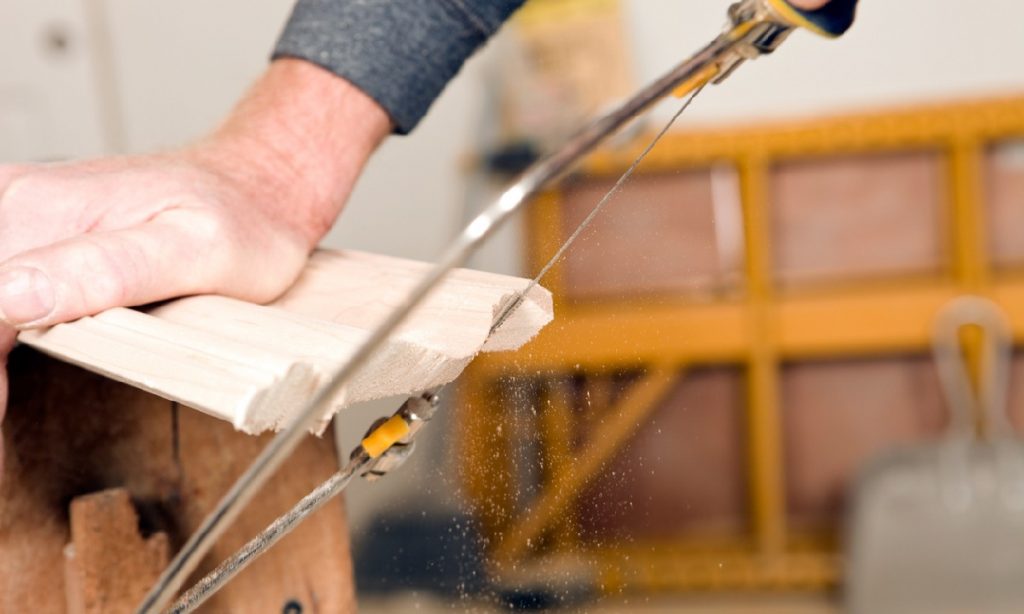What Do You Use a Coping Saw for?

A coping saw is a type of bow saw which contains a very thin metal blade that allows you to cut wood in various angles. This saw is commonly used by woodcutters and trim carpenters when they need to etch detailed and complicated shapes into thin materials like wood and plastic.
In this article, we’ll take a closer look at what a coping saw is used for with practical examples of its application. So, let’s dive right in!
What Is a Coping Saw?
A coping saw is equipped with a very thin metal blade which is usually 4-6 inches in length and contains hundreds of edged little teeth. Both ends of the blade are fastened to a rotating spigot which is supported by a C-shaped metal frame.
With the help of the thin blade and rotating spigot, you’re able to accurately make complicated designs into thin materials. Though fret saw machines are available as a modern replacement, coping saws are still a practical choice of trim carpenters for cost-effective yet accurate cuts into objects.
What Is a Coping Saw Used for?
A coping saw is used for making intricate external and interior cut-outs in carpentry or trim work. They are used to cut thin materials like plastic and wood, while some of them can also cut ceramic tiles and certain metals. Here are some practical examples of coping saws’ applications:
Creating Joints for a Timber Cornice
Joining the cornice from different corners of a room is a complicated part of installing one. The joints of the cornice need to be shaped accurately for strong and neat attachment. A coping saw is an effective way to create joints for a timber cornice as it allows precise cutting of joints at the right angles.
Cutting a Hole With a Coping Saw
There are many instances where a woodcutter or trim carpenter may not be able to cut a hole into an object, for example, when devising a hole into a desk for cable management. A coping saw is a useful tool for this purpose. To do that, you can remove the blade of the saw, trace the cut area and then drill a hole at the center of the cut. The next steps would be to reattach the blade, adjust the angle, and start cutting.
Creating a Dovetail Joint
A dovetail joint, also called the dovetail, is a popular woodworking and log building technique that requires cutting finger-like joints between two pieces of wood to allow for a tight joint. Woodcutters and trim carpenters widely use coping saws for creating strong dovetail joints as these require a top-tier accuracy.
How to Use a Coping Saw
The first step is assembling your coping saw. During the assembly, ensure the blade’s teeth point toward the handle so they’re functional when the saw is pulled, rather than when the saw is pushed. This technique promotes the longevity of your saw while ensuring accurate cut-outs that require minimum effort.
When cutting a shape into a material using a coping saw, you should detach the blade from the saw and place it through the object to adjust the angle. Then, attach the blade and start cutting to create the desired cut-out.
How to Maintain a Coping Saw
To maintain a coping saw, avoid touching the blade’s teeth and keep any other objects from interfering with the blade. Also, make sure the blade is tightened up before use.
If the blade’s teeth become blunt or break, it’s recommended you replace the blade instead of sharpening its teeth. We also suggest oiling the saw after each use to ensure smooth cutting into woods and other materials.
Final Words
Despite the availability of modern solutions like fret saw machines, coping saws are still widely used by trim carpenters and woodcutters to create complex shapes into wood and other objects. Though coping saws require experience and competence, they’re a great tool for accurate cut-outs and shapes into different materials.
